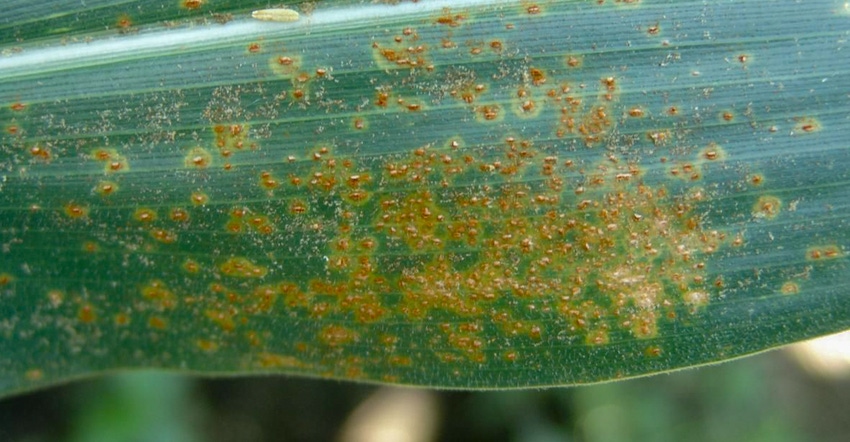
On top of the numerous other challenges this year, 2020 saw a surprising number of counties in Nebraska and other Midwestern states infected with southern rust in corn. That's in spite of the dry conditions that persist in parts of Nebraska and Iowa.
Tamra Jackson-Ziems, Nebraska Extension plant pathologist, says there are a couple of reasons for this.
"No. 1 is the southern rust fungus doesn't require as much moisture or relative humidity as some of the other fungi, like the gray leaf spot fungus," Jackson-Ziems says. "The gray leaf spot fungus needs 95% humidity or higher for 11 or more hours to infect. In contrast, the fungus that causes southern rust needs similar conditions for only about six hours. We're probably getting enough moisture at least in the lower canopy for infection."
"No. 2 is inoculum," she adds. "Unfortunately, the states to the south of us are seeing more southern rust than they have in recent years. I think we got an early start because of the prolonged windy days we had this summer, carrying the inoculum farther north into Nebraska."
While all fungi need a high relative humidity in order to produce germ tubes and infect the plant through the leaf surface, the fungus that causes southern rust needs humid conditions for less time.
While the southern tier of counties in Nebraska are used to seeing southern rust to some extent almost every year, the inoculum spread earlier and farther north than usual. As of mid-August, the disease had been identified in more than 50 counties in Nebraska.
"In the southern counties in Nebraska, they see southern rust almost every year. It may be an issue in some counties and not as big of a deal in others," Jackson-Ziems says. "This year, it started early, and we're seeing it all the way into the northern counties, where they're not as used to watching for it."
Fungicide challenges
The question is, when is the right time to spray fungicide to protect against southern rust? Once corn has reached the mid- to late-dough stages, it's probably too late to be economically feasible.
However, Jackson-Ziems also advises against spraying as soon as southern rust is confirmed in a county, as it can take two or more weeks to spread across the county. And spraying too early risks the fungicide residual wearing off before southern rust reaches the field.
"Southern rust is a very patchy disease," she says. "It's partially due to the fact we have spore showers, where the wind currents carry in spores, and they drop out in small patches in fields. If conditions are favorable, they infect and cause disease. Then, we get secondary spread within the field. The initial infections may only occur in tiny wads about the size of a half-dollar, and there may not be very many at all. When people see those pustules, I encourage them to give it a week, and then maybe you'll start to see a few more individual pustules, and then you know it's spreading."
Looking to harvest
The yield loss from southern rust depends on several factors, including the disease severity in the field and the susceptibility of the hybrid planted. However, without management, southern rust alone can cause yield loss of up to 40%, although that level of loss is more common in Southern states.
"The same amount of fungus causes far more damage than an equivalent amount of fungus that causes gray leaf spot," Jackson-Ziems says. "That's because the rust pustules rip open a wound in the epidermis of the leaf, to it push spores in. Having so many microscopic rips in the epidermis hurts the plant's ability to regulate water loss.
"Southern rust or any disease affecting a large amount of leaf area will also increase the chance of lodging or stalk rot diseases later in the fall. In fields where they have a lot of disease, growers should test their stalk strength. If they find fields with stalks more vulnerable to lodging, those are fields they'd want to harvest first."
Southern rust, unlike some other fungal diseases such as gray leaf spot or northern corn leaf blight, does not overwinter in Nebraska — so an infection this year does not necessarily mean it will reoccur in the same field next year. However, it's still a good idea to monitor states and counties to the south for infection, which can be done online at corn.ipmpipe.org/southerncornrust.
About the Author(s)
You May Also Like






